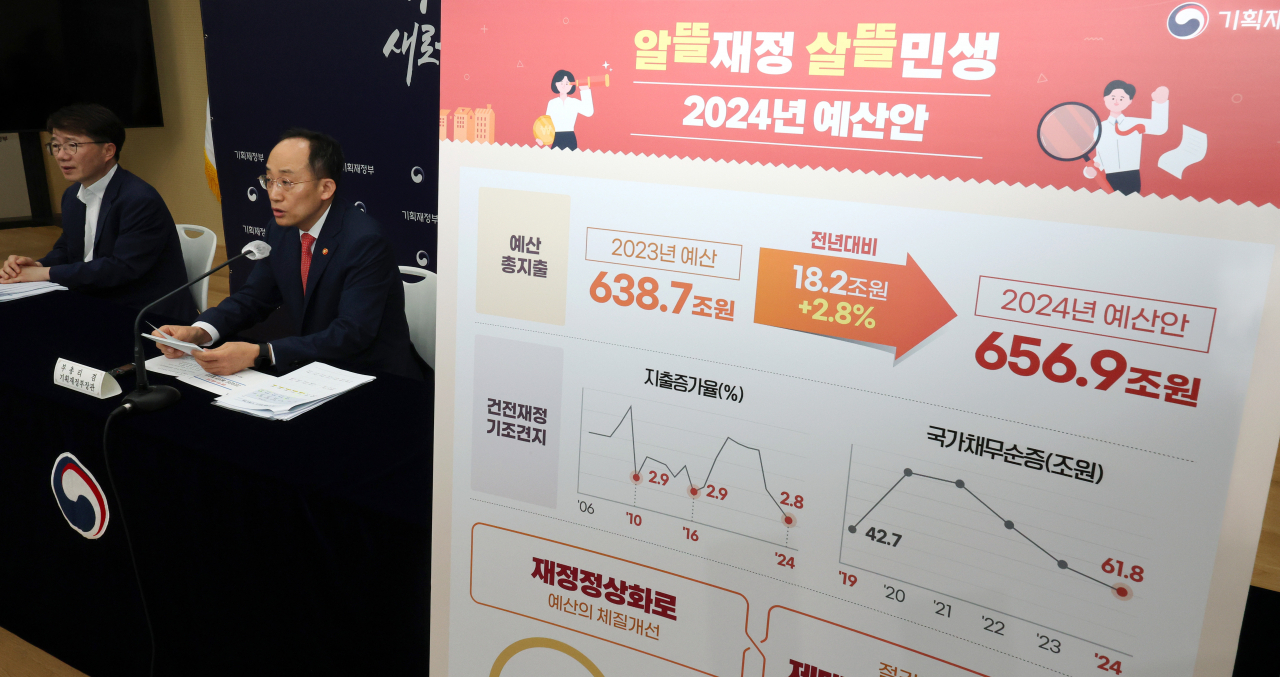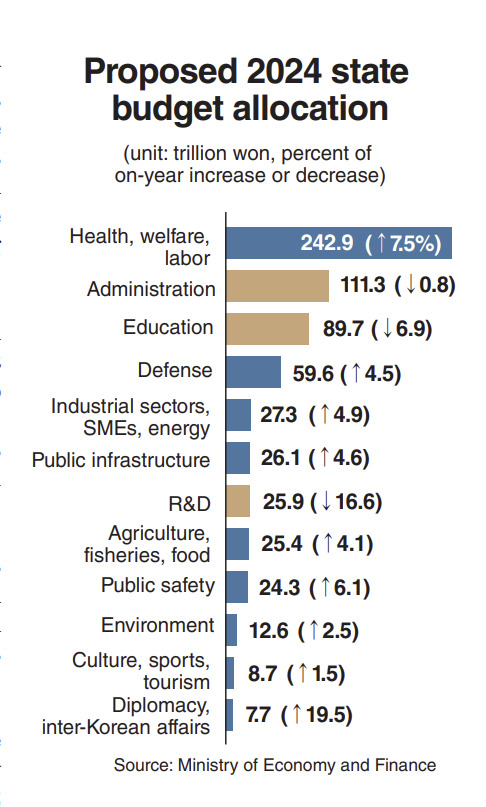A look into next year's budget for welfare, defense
By Ji Da-gyum, Lee Jaeeun, Park Jun-heePublished : Aug. 29, 2023 - 17:42

Defense
South Korea's Defense Ministry has proposed to raise expenditures by around 17 percent to advance the development of an indigenous three-axis defense system, aimed at countering North Korean missile and nuclear threats and retaliating in the event of an attack.
Total defense spending is estimated at approximately 59.6 trillion won ($45.1 billion), a 4.5 percent increase from last year, according to the ministry.
An estimated 41.8 trillion won is earmarked for expenditures related to force operations and maintenance, reflecting a 4.2 percent on-year increase. The allocation encompasses costs associated with operating and sustaining military equipment and facilities, as well as other outlays like personnel salaries, benefits, training and education.
The budget allocated for "force improvement," aimed at military buildup, is proposed to increase by 5.2 percent, reaching around 17.8 trillion won.
"We are focused on significantly enhancing our core capabilities and asymmetric response including advancing the Korean-style three-axis system to counter North Korean nuclear and missile threats as well as establishing an AI-based combat system that integrates manned and unmanned systems," the Defense Ministry said.
Around 7.16 trillion won has been allocated to the three-axis defense system, a substantial increase of 16.8 percent, which is equivalent to 1.03 trillion won compared to the budget of the current year, a senior official said during a closed-door briefing.
The three-pronged defense system consists of the Kill Chain preemptive strike mechanism, Korea Air and Missile Defense (KAMD), which aims to build complex and multi-layered missile defense shields, and the Korea Massive Punishment and Retaliation (KMPR).
Around 3.3 trillion won, 1.57 trillion won and 750 billion won are respectively earmarked for the Kill Chain, KAMD, and KMPR. The remaining 1.54 trillion won was distributed to surveillance and reconnaissance as well as command and control capabilities.
About 650 billion won has been earmarked for acquiring an additional 20 FA-35A stealth fighter jets, in alignment with the Kill Chain strategy. This demonstrates a significant escalation from this year's budget of 18.8 billion won.
In order to adeptly address the shifting dynamics of the future battlefield, the South Korean military also is dedicated to forging an AI-based Manned and Unmanned Teaming (MUM-T) framework that includes unmanned reconnaissance vehicles. This initiative is supported by a budget allocation of 213.6 billion won.
Meanwhile, South Korea's Unification Ministry has put forward a proposal for around 1.1 trillion won in total expenditure for the upcoming year, reflecting a 22.2 percent year-on-year decrease, amidst the prolonged inter-Korean stalemate.
The ministry designates roughly 874.2 billion won for the inter-Korean cooperation fund, showcasing a reduction of 27.9 percent from the around 1.21 trillion won allocated this year. Within the fund, the ministry clarified that over 40 percent of the budget allocated for inter-Korean economic cooperation, including projects associated with the now-closed Kaesong Industrial Complex, has been decreased due to the difficulties in advancing these activities.
The remainder of the budget is allocated to other general projects, totaling 234.5 billion won, marking a 5 percent increase compared to the current year.
The primary focus of the overall budget is to enhance public understanding of the human rights situation in North Korea, ensure accurate dissemination of information about the reality of North Korea, and allocate funds for practical resettlement support for North Korean defectors.
Inter-Korean affairs
The Unification Ministry has unveiled a comprehensive strategy to establish the National North Korean Human Rights Center, aimed at amplifying the public's understanding of the reality of North Korean human rights and fostering a nationwide appreciation for values centered around "freedom and human rights."
This center will serve as both an exhibition space and an interactive platform to engage with North Korean human rights issues, while also acting as a central hub for the collection and distribution of human rights-related content to audiences both within the country and internationally.
In pursuit of this goal, the ministry allocates 10.4 billion won for the upcoming year within the framework of the total expenditure of 26 billion won. The center's anticipated opening is slated for early 2026.
Additionally, approximately 1.62 billion is earmarked for a new project titled "Enhancing Awareness of Unification and Understanding of North Korea." This initiative seeks to create and disseminate content that effectively communicates the realities of North Korea, targeting both domestic and international audiences.

Welfare
The Ministry of Health and Welfare is seeking to secure a 122.5 trillion won ($92.3 billion) budget for 2024, a 12.2 percent increase from this year's basic budget, according to its spending plan.
South Korea's 2024 budget for health and welfare emphasizes "strengthening welfare for the weak," according to the ministry. While the country has increased its health and welfare spending over the years, next year's budget aims specifically to cover welfare blind spots and invest in the future, as the country faces a rapidly aging population, declining medical personnel and a continually falling birth rate.
The government plans to expand the basic livelihood allowance given to those in the lowest income bracket by 13.16 percent next year, while spending more in an attempt to solve the critically low birth rate by offering larger cash incentives to parents with a newborn.
Families are currently receiving 700,000 won in cash per month per infant up to the age of one and 350,000 won per month per infant through age two, with the cash payments set to rise to one million won and 500,000 won, respectively, in 2024. The costs for fertility tests and egg freezing will be covered for married couples preparing for pregnancy.
Starting with high- and medium-risk groups next year, the National Mental Health Investment Project will be newly established so that those groups can receive psychological counseling services if necessary, expanding to other groups by 2026.
The spending plan also includes doubling the number of pediatric emergency rooms nationwide and strengthening the competitiveness of the bioindustry and digital health fields.
Education
The Education Ministry is seeking to secure a 95.6 trillion won ($72.39 billion) budget for 2024, a 6.2 trillion won on-year decrease, to revive universities in regional areas and nurture high-tech talents, as well as help schools shift to AI digital textbooks.
The ministry’s top priority is to bridge the gap between universities inside and outside of Seoul. It will also team up with local governments so that universities can offer a better educational system and young students can seek better career options there.
The ministry will focus on supporting semiconductor-specialized universities so that they can foster science talents at the undergraduate and postgraduate level.
More government-supported scholarships will be offered to alleviate the burden of tuition costs for students, and college tuition will be free for students from low-income families. The ministry also plans to increase its educational expense support for lower-income students in kindergarten and elementary to high schools, allowing them to benefit from various educational activities.
Some 68.8 trillion won will be given to local education offices across the nation. The budget will be used for the transition of AI digital textbooks which will be introduced in 2025, integrating the supervision of nurseries, kindergartens and more.
Next year’s budget will also be used for overseas Korean language education, where Korean teachers will be dispatched to local schools, and Korean language textbooks will be distributed abroad.





















